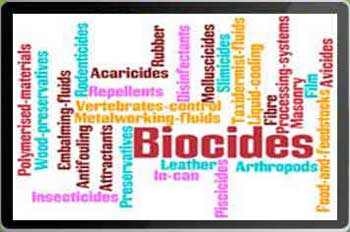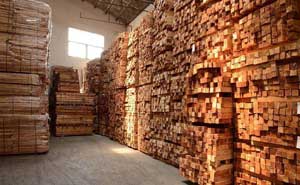Abstract
Octylisothiazolinone (OIT) is a highly effective fungicide. It is widely used in the anti-mold of leather and paint, but the anti-mold effect in wood protection is rarely reported. In this paper, OIT was used as the main fungicide to test the anti-mold and anti-blueing properties of the ethanol solution and emulsified preparation for the treatment of rubberwood, in order to provide technical reference for its application in wood protection.
Content Table:
Overview
The rubber tree is one of the main crops of tropical agriculture in my country. The planting area is more than 1.3 million m2. The annual output of the rubber gardens is about 3 million m3. Rubberwood has excellent physical and mechanical properties. Its materials are elegant, beautiful in texture, moderate in price, and stable in supply. Since the 1980s, rubberwood has become an important commercial forest material produced in tropical regions of China.
Because rubberwood is rich in nutrients such as starch. It is extremely vulnerable to biological damage factors. Such as mold, cyanobacteria, and borers. This can only be processed and used after being preservative treated. Boron phenol (boric acid, borax, and sodium pentachlorophenol) is widely used to treat rubberwood. Among them, sodium pentachlorophenol plays a good role in preventing mildew and blueing. And it is easy to use and low cost. In the last century, 80% of global PCP production was used for wood preservation.
However, PCP is more toxic and causes serious environmental hazards. And industrial PCP often contains carcinogen dioxin. Currently, PCP has been banned. Looking for highly effective and environmentally friendly mildew-proof and blue-proof agents is an urgent problem to be solved.
Isothiazolinone derivatives are a general term for a class of compounds containing oxazoline rings. Because of its high-efficiency, broad-spectrum antibacterial properties, good compatibility, and a wide range of pH values, it is widely used in industrial fields.
Some scholars have studied the anti-mold effect of CMIT/MIT and DCOIT on bamboo. The results show that CMIT/MIT has a good control effect on a variety of molds and discoloring bacteria such as Aspergillus niger, Penicillium citrinum, and Cocococcus spp. DCOIT is less effective than CMIT/MIT. The combination of CMIT/MIT and carbendazim can significantly improve its antibacterial activity.
Octylisothiazolinone (OIT) is a highly effective fungicide. It is widely used in the anti-mold of leather and paint, but the anti-mold effect in wood protection is rarely reported. In this paper, OIT was used as the main fungicide to test the anti-mold and anti-blueing properties of the ethanol solution and emulsified preparation for the treatment of rubberwood, in order to provide technical reference for its application in wood protection.
Indoor test process
After a 4-week indoor test. The control efficacy of OIT treatment on the four strains (P. violaceum, Aspergillus fumigatus, cyanobacteria, Cocococcus spp.) is very different. Among them, Octylisothiazolinone (OIT) has the best control effect on Penicillium purpura and Aspergillus fumigatus. When the mass fraction of the treatment solution reaches 0.8%, the control effect on Penicillium purpureum can reach 100%. The control effectiveness against Aspergillus fumigatus can reach 88%. OIT has a poor control effect on the cyanobacteria cocoa spores. With a quality score of 0.8%, the control effectiveness is 71%.
The control efficacy of the three test bacteria increased with the increase of the mass fraction of the treatment solution. When the mass fraction reaches 0.6%, it can effectively control Penicillium purpurum and Aspergillus fumigatus. The mass fraction of effective control of Cocoa spores should be 0.8% or higher. OIT is less effective against Trichoderma harzianum. Almost ineffective at low-quality scores. When the mass fraction of the treatment liquid reached 0.8%, its control effect was only 21%.
Outdoor test process
The minimum mass fraction of vacuum pressure treatment is set at 0.2%, with a gradient of every 0.2%. The minimum mass fraction of atmospheric impregnation treatment is set at 0.3%, with a gradient every 0.3%. After two weeks of field trials, the surface of the material was completely covered with mold. The processed materials have also been violated to varying degrees. In the case of vacuum-pressurized specimens, when the mass fraction of the treatment fluid is less than 0.4%, the infection is more serious. When the quality score reaches 0.6% or more, the infection degree of the test piece is relatively light. The impregnated specimens showed the same pattern. When the mass fraction of the treatment solution reached more than 0.6%, its infected area was very small. When the mass fraction of the treatment solution is less than 0.6%, the infected area increases significantly. This shows that at the beginning of the test, the anti-mold performance of the test material is mainly determined by the mass fraction of the treatment solution.
As the experiment progressed, the infected area gradually increased. By the sixth week, no matter what kind of process, the test materials treated with low mass fractions were very seriously infested by mold and discoloration bacteria. The surface of individual specimens was completely covered by mold. The samples processed with high-quality scores are in better condition. And the average infected area decreases with the increase of the mass fraction of the treatment solution.
This rule was not obvious at the beginning of the experiment. This may be caused by some accidental factors. For example, the test piece on the outside of the pile is always more likely to come in contact with the mold spores than the internal test. Therefore, it showed signs of infection by mold earlier.
By the end of the test, when the mass fraction of 0.6% or higher is reached, the vacuum pressure treatment is better than the impregnation treatment for mold resistance. When vacuum pressurized at 0.2% and 0.4% mass fraction, although the drug loading of the treated material reached or even exceeded the high-quality fraction impregnated test material. But its mildew resistance is poor. This may be due to the fact that the drug penetrated more into the test piece during vacuum pressure treatment. The drug content on the surface of the test piece is not necessarily significantly higher than the impregnated material.
The results of indoor mildew control experiments show that Octylisothiazolinone has a poor control effect on some important molds that invade rubberwood. This caused the treated material to be infected with mold in the short term outdoors, and the infected area gradually expanded with time.
Conclusion and discussion
The indoor test results show that OIT has a better control effect on Penicillium purpurum and Aspergillus fumigatus. It also has a certain control effect on Cocoa spores. But it has almost no control effect on Trichoderma harzianum. The effectiveness of OIT against mold and cyanobacteria increases with its mass fraction.
The results of outdoor tests show that the OIT treatment of rubberwood has a certain effect on preventing mildew and blueing. But it can not completely protect rubberwood from mold and blue stain bacteria.
Compared with bactericides such as IPBC and carbendazim, the control effect of OIT on Trichoderma harzianum, Cocoa cocci, and other bacteria is relatively poor. But the economic cost of OIT is only one-third of IPBC. And it is easy to prepare a stable emulsified preparation. It is easy to mix with other agents and can be applied in a wide range of pH values. Therefore, OIT is suitable for compounding other fungicides to prepare compound antifungal agents. On the one hand, it can obtain a broader spectrum of bactericidal properties through compounding, and on the other hand, it can reduce the cost of drugs.
Combining the results of indoor mold prevention test and outdoor test, when OIT is used in combination with other fungicides, the mass fraction of Octylisothiazolinone (OIT) in the treatment solution should reach 0.6%; The quality score should be 0.8% or higher.







